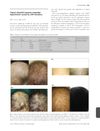Search
for
Sort by
Research
330-360 / 516 resultsresearch Faculty Opinions Recommendation of Association of Topical Minoxidil with Autosomal Recessive Woolly Hair/Hypotrichosis Caused by LIPH Pathogenic Variants
research Enanthem in Patients With COVID-19 and Skin Rash
Minoxidil can improve hair growth in some patients with woolly hair due to LIPH variants, with varying responses and mild side effects.

research Topical Minoxidil Improves Congenital Hypotrichosis Caused by LIPH Mutations
Applying minoxidil can help improve hair growth in people with hair loss caused by LIPH gene mutations.
research Clinical and Trichoscopic Characteristics of Temporal Triangular Alopecia: A Multicenter Study
Temporal triangular alopecia is a non-scarring hair loss in children, often linked to other health conditions.

research Hair Growth Promoting Effects of Adipose Tissue-Derived Stem Cells
Fat tissue stem cells may help increase hair growth.

research Effects of Topical Application of Growth Factors Followed by Microneedle Therapy in Women with Female Pattern Hair Loss: A Pilot Study
Growth factors and microneedle therapy increase hair density in women with hair loss.

research The Hair Follicle Enigma
The document concludes that understanding hair follicles requires more research using computational methods and an integrative approach, considering the current limitations in hair treatment products.

research Tracing Selection Signatures in the Pig Genome Provides Evidence for Selective Pressures on a Unique Curly Hair Phenotype in Mangalitza
Selective breeding caused the unique curly hair in Mangalitza pigs.

research Effects of a Gintonin-Enriched Fraction on Hair Growth: An In Vitro and In Vivo Study
Gintonin-enriched fraction promotes hair growth and could be a potential alopecia treatment.

research FGF Signaling for Hair Cycle Resting Phase Alleviates Radiation Alopecia
FGF18 treatment during hair's resting phase can protect against hair loss from radiation.

research Acquired Progressive Kinking of the Hair in the Setting of Parry-Romberg Syndrome
A woman with Parry-Romberg syndrome developed new curly hair on one side of her scalp, a condition not previously linked to the syndrome.

research Hair Abnormalities and Neurological Disease
Hair changes could indicate neurological diseases and help monitor treatment.

research Single-Cell Transcriptomics Reveals the Molecular Anatomy of Sheep Hair Follicle Heterogeneity and Wool Curvature
The research identified genes that explain why some sheep have curly wool and others have straight wool.

research Identification of the Key Proteins Associated With Different Hair Types in Sheep and Goats
Different proteins are linked to the varying thickness of sheep and goat hair types.
research Frizzy Hair Pathology
Frizzy hair is fragile and can lead to hair loss and damage if not properly cared for.
research Human Hair Shaft Proteomic Profiling: Individual Differences, Site Specificity, And Cuticle Analysis
Human hair proteins vary by individual, body site, and ethnicity, useful for forensics.

research Altered Hair Root Gene Expression Profiles Highlight Calcium Signaling and Lipid Metabolism Pathways Associated With Curly Hair Initiation and Maintenance in Mangalitza Pigs
Genes related to calcium signaling and lipid metabolism are important for curly hair in Mangalitza pigs.

research Alopecia in Epidermolysis Bullosa
The document suggests that certain protein deficiencies and scalp blistering in Epidermolysis Bullosa may cause hair loss.
research Multi-Stage Transcriptome Analysis Revealed the Growth Mechanism of Feathers and Hair Follicles During Induction Molting by Fasting in the Late Stage of Egg Laying
Fasting in hens affects thyroid hormones, which regulate feather and hair growth.

research Lrig1-Expressing Epidermal Progenitors Require SCD1 to Maintain the Dermal Papilla Niche
Hair growth-related cells need the enzyme SCD1 to help maintain the area that supports hair growth.

research Canonical Wnt-10b Signaling Exerts an Ability to Maintain Mouse Dermal Papilla Cells
Wnt-10b is important for keeping mouse skin cells healthy for hair growth.

research Case of Baldness Treated with Individualized Homeopathic Remedy
Homeopathy helped a 30-year-old man regrow his hair.

research Keratosis Follicularis Spinulosa Decalvans: Case Report
A rare genetic disease caused severe, worsening hair loss from early childhood with poor treatment results.

research Increased Macrophage Migration Inhibitory Factor in the Sera of Patients with Extensive Alopecia Areata
Patients with severe alopecia areata have higher levels of MIF, which decrease after successful treatment.

research Non-Edg Family LPA Receptors: The Cutting Edge of LPA Research
New LPA receptors (LPA4, LPA5, LPA6) have diverse roles in the body.

research Transcriptome Analysis of Improved Wool Production in Skin-Specific Transgenic Sheep Overexpressing Ovine β-Catenin
Genetically modified sheep with more β-catenin grew more wool without changing the wool's length or thickness.

research DNA Dioxygenases Tet2/3 Regulate Gene Promoter Accessibility and Chromatin Topology in Lineage-Specific Loci to Control Epithelial Differentiation
The enzymes Tet2 and Tet3 are important for skin cell development and hair growth.

research Genetics of Alopecia
Different genes are linked to various types of hair loss.

research White Piedra Caused by Trichosporon Inkin: A Report of Two Cases in a Northern Climate
White piedra, a rare fungal infection, was diagnosed in two women in a northern climate.